BizTx/BizTx Group Editor
This chapter describes the functions and uses of the BizTx/BizTx Group editor.
1. Creating a BizTx/BizTx Group
A BizTx/BizTx Group is a business resource that is needed to run the AnyLink Runtime Engine Server (hereafter RTE). BizTx and BizTx Group resources are represented in a tree structure. BizTx and BizTx structure consist of request, response, and abnormal response messages. The main purpose of the BizTx tree is to parse the request message and call the appropriate service from the AnyLink engine according to the content of the parsed message.
A BizTx/BizTx Group consists of three node types, the root BizTx Group, intermediate BizTx Group, and leaf BizTx.
Creating the Root BizTx Group
To create the root BizTx Group, select [New] > [BizTx/BizTx Group] from the Project resource’s context menu in the Navigator. Enter the required items in the Create BizTx/BizTx Group window, and then click [Finish].
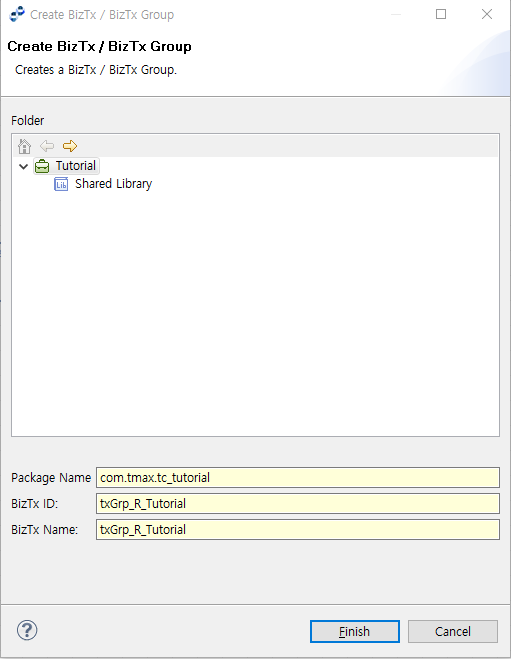
| Item | Description |
|---|---|
Package Name |
Package name for the BizTx. A directory with the package name is automatically created. (Example: com.tmax.tc_tutorial) |
BizTx ID |
BizTx resource ID. Only alphanumeric and special (_) characters are allowed, and the first character must be in lowercase. |
BizTx Name |
BizTx name. Only Korean, alphanumeric, and special characters are allowed. Must follow the XML naming convention. |
Creating a BizTx/BizTx Group
To create a BizTx Group, select [New] > [BizTx/BizTx Group] from the Project resource’s context menu in the Navigator. Enter the required items in the Create BizTx/BizTx Group window, and then click [Finish].
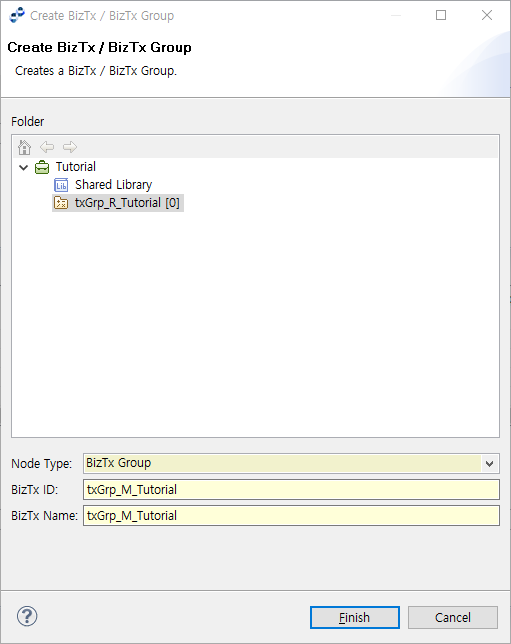
| Item | Description |
|---|---|
Node Type |
Node type (BizTx Group or BizTx). |
BizTx ID |
BizTx resource ID. Only alphanumeric and special (_) characters are allowed, and the first character must be in lowercase. |
BizTx Name |
BizTx name. Only Korean, alphanumeric, and special characters are allowed. Must follow the XML naming convention. |
2. BizTx/BizTx Group Editor
BizTx/BizTx Group editor consists of BizTx (Group) Info, BizTx (Group) Options, Parsing Info, Parsing Options, XML Viewer tabs. To access each tab, click on the desired tab at the bottom of the resource view.
2.1. BizTx/BizTx Group Info
The [BizTx/BizTx Group Info] tab consists of Basic Info, Request Message, Normal Response Message, Business Error Message, Error Response Processing, and Invocation Service sections. Invocation Service is only applicable to a BizTx.
Basic Info

| Item | Description |
|---|---|
BizTx Group ID |
BizTx Group ID. |
Package Name |
Package name. |
BizTx Group Name |
BizTx Group name. |
BizTx Type |
BizTx type used to classify BizTx for monitoring. A BizTx type can be registered through the [Import Configuration] menu. |
Version |
Automatically assigned at deploy time. |
Description |
Description of the BizTx Group (optional). |
Bypass |
Deliver the message without transformation when BizTx request message and service request message are the same for a single backend service call. Can only be used for an Outbound Rule with Bypass enabled Invocation service.
|
XA |
Global transaction setting. Process multiple messages in a single global transaction using the 2PC protocol (prepare, commit, and rollback) through adapters, such as Tmax and Web service, that support transactions.
|
BizTx Invocation Service (BizTx)
The following describes the BizTx Invocation Service section of the [BizTx Info] tab for a BizTx. The invocation service can call a Flow, Outbound Rule, or Multi-binding service.
-
Flow
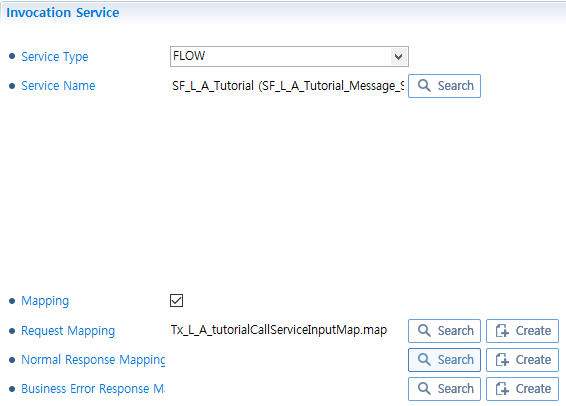 [BizTx (Group) Info] - [Invocation Service (Flow)]
[BizTx (Group) Info] - [Invocation Service (Flow)]Item Description Service Type
Set to 'Flow'.
Service Name
Flow service name. Use [Search].
Mapping
Option to map BizTx’s Request/Normal Response/Business Error Response Message to Input/Output/Error parameter of the Flow’s start event.
-
Request Mapping: Click [Search] to select an existing mapping file or click [Create] to create mapping between the Flow’s start event INPUT parameter and request message.
-
Response Mapping: Click [Search] to select an existing mapping file or click [Create] to create mapping between the Flow’s start event OUTPUT parameter and response message.
-
Error Response Mapping: Click [Search] to select an existing mapping file or click [Create] to create mapping between Flow’s start event ERROR parameter variable and error response message.
-
-
Outbound Rule
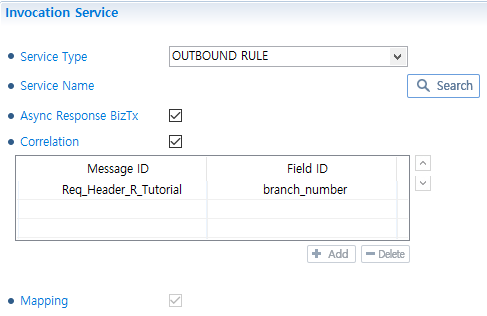 [BizTx (Group) Info] - [Invocation Service (Outbound Rule)]
[BizTx (Group) Info] - [Invocation Service (Outbound Rule)]Item Description Service Type
Set to 'OUTBOUNDRULE'.
Must be set to 'OUTBOUNDRULE' for Bypass enabled BizTx.
Service Name
Outbound Rule service name. Use [Search].
If Bypass is set for the BizTx, only Bypass enabled service can be selected.
Async Response BizTx
To use an Async Response BizTx, set 'BizTx Identifier Code' to either 'RESPONSE' or 'ERROR_RESPONSE' in [Parsing Info] > [Parsing Definition].
The following describes the 'BizTx Identifier Code'.
-
When BizTx is set to 'RESPONSE' or 'ERROR_RESPONSE': BizTx can execute the service regardless of the Response Option value. However, the service type must be set to TCP Outbound Rule with async response mode. Otherwise, the Response Option is automatically changed to ASYNC type when Async Response BizTx is selected.
-
When set to 'RESPONSE': BizTx’s request message is added to the Normal Response Message of the TCP Outbound Rule.
-
When set to 'ERROR_RESPONSE': BizTx’s request message is added to the Business Error Response Message of the TCP Outbound Rule.
If this item is selected, the Mapping item is unavailable.
Correlation
Message field used as correlation field of the message for Async Response BizTx. If the 'BizTx Identifier Code' is set to 'RESPONSE', the message is a Normal Response Message. If it is set to 'ERROR_RESPONSE', the message is a Business Error Response Message.
Correlation cannot be used for a Bypass enabled BizTx.
Mapping
Option to map BizTx’s Request/Normal Response/Business Error Response Message to Outbound Rule’s Request/Response/ Business Error Response Message.
-
Request Mapping: Click [Search] to select an existing mapping file or click [Create] to create mapping between Request Messages of BizTx and Outbound Rule.
-
Response Mapping: Click [Search] to select an existing mapping file or click [Create] to create mapping between the Response Messages of Outbound Rule and BizTx.
-
Error Response Mapping: Click [Search] to select an existing mapping file or click [Create] to create mapping between the Business Error Response Messages of Outbound Rule and BizTx.
Mapping cannot be used for a Bypass enabled BizTx.
-
-
Multi-binding
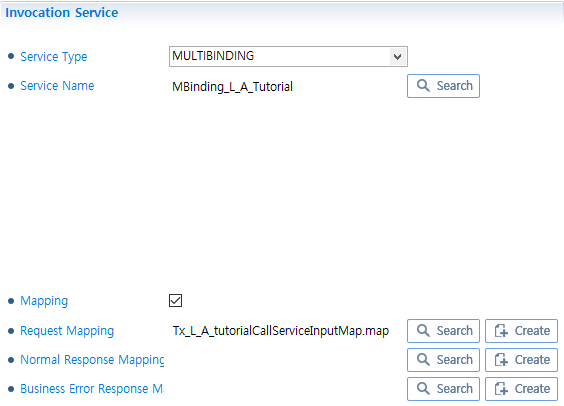 [BizTx (Group) Info] - [Invocation Service (Multi-binding)]
[BizTx (Group) Info] - [Invocation Service (Multi-binding)]Item Description Service Type
Set to 'MULTIBINDING'.
Service Name
Multi-binding service name. Use [Search].
Mapping
Option to map BizTx’s Request/Normal Response/Business Error Response Message to Multi-binding’s Request/Response/ Business Error Response Message.
-
Request Mapping: Click [Search] to select an existing mapping file or click [Create] to create mapping between Request Messages of BizTx and Multi-binding.
-
Response Mapping: Click [Search] to select an existing mapping file or click [Create] to create mapping between the Response Messages of Multi-binding and BizTx.
-
Error Response Mapping: Click [Search] to select an existing mapping file or click [Create] to create mapping between the Business Error Response Messages of Multi-binding and BizTx.
-
Request/Normal Response/Business Error Response Message
A BizTx/BizTx Group consists of messages. When a message is added to a BizTx Group, the message definition is inherited by its child nodes.
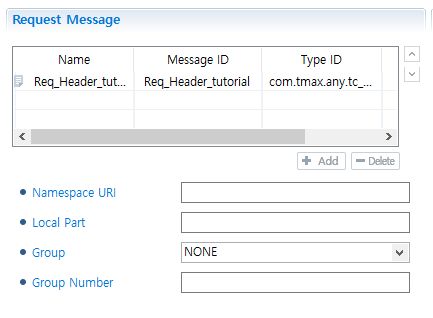
| Item | Description |
|---|---|
Request Message |
Request message for BizTx. |
Normal Response Message |
Normal response message for BizTx. |
Business Error Response Message |
Business error response message for BizTx. A business error is any error that is not a system error. System errors are handled according to the description in the "Error Response Handling" section. |
After creating a message in the Message Editor, click [+Add] to open the dialog box for selecting and adding a message. The configuration items and method are same for Request, Normal Response, and Business Error Response Messages.
The following is the window for adding a request message.
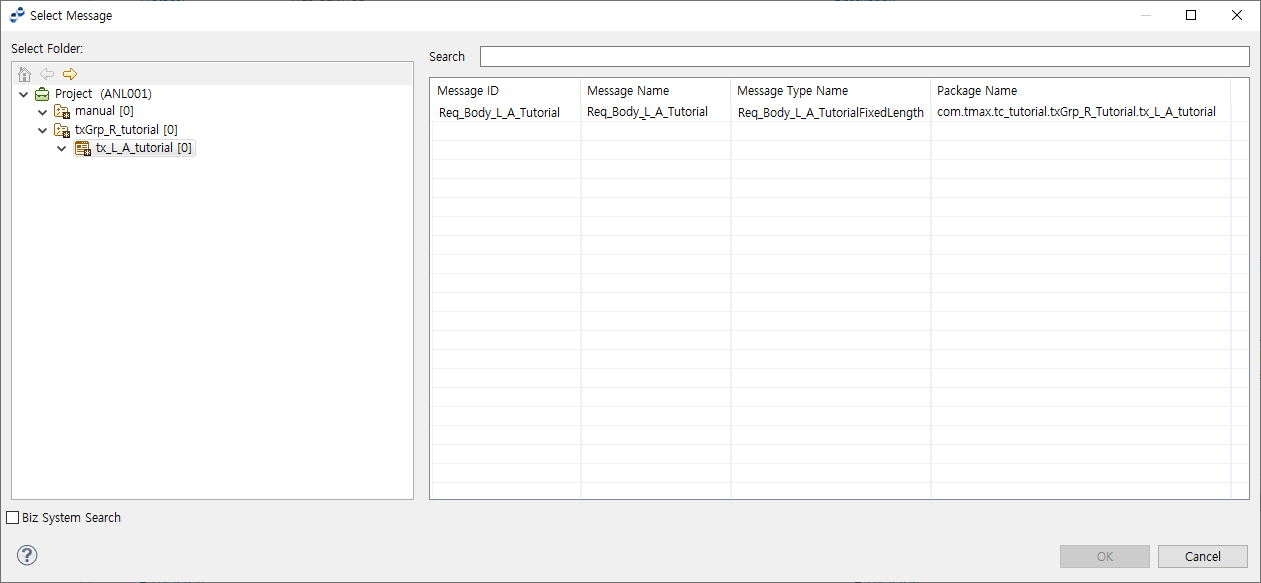
Select a Project or BizTx (Group) from the Navigator on the left to display its messages in the table on the right. If a message is selected, the message is displayed in the table. The message type can be edited from the table. Select a message to set it as a Request Message.
|
Since AnyLink resources form the BizTx nodes of a hierarchy, the resources of a parent BizTx node cannot reference the resources of a child BizTx node. |
Select Search Biz System to search for messages in all projects of the Biz System. Entering a search word in Search searches for messages with ID and name that include the word.
If another project’s message is selected, the BizTx node of the message is created as a symbolic link. Before deploying the BizTx, the BizTx node created with the symbolic link must be deployed first.
The following are the common configuration items for Request, Normal Response, and Business Error Response Messages.
| Item | Description |
|---|---|
Namespace URI |
Used to form the message’s namespace together with the Local Part when a Request/Normal Response/Business Error Response Message is an XML type. |
Local Part |
Used to form the message’s namespace together with the Namespace URI when a Request/Normal Response/Business Error Response Message is an XML type. |
Group |
Used in the BizTx of SOAP header. Created as an XML tag. |
Group Number |
Group order. |
Error Response Handling
This section is used to configure error response handling.
-
NONE
No processing.
-
PARENT
Inherit parent BizTx node’s setting.
-
FLOW
The following tabs are displayed when FLOW is selected. Each tab represents each error response type.
Tab Description [System Error Response]
Handling for system errors.
[Format Error Response]
Handling for data type mismatch error when converting a message into a data object.
[BizTx Restriction Exceeded Error Response ]
Handling for when a BizTx restriction set in WebAdmin is exceeded.
[Parsing Error Response]
Handling for when a child node is not found.
[Duplicate BizTx Error Response]
Handling for duplicate BizTx with a value added in Check Duplicate BizTx Field when Check Duplicate BizTx is set to Yes.
[Service Error Response]
Handling for errors thrown by a flow or outbound rule.
[Correlation Error Response]
Handling for flow correlation errors.
Select the 'Error Response Message' checkbox for the desired message type to set the error response message. If the Error Response Handling is set to 'FLOW', the service flow with the specified 'Service ID' is called when a matching error type occurs.
 [BizTx (Group) Info] - [Error Response Mode (FLOW)]
[BizTx (Group) Info] - [Error Response Mode (FLOW)]The following describes each item.
Item Description Error Response Message
-
Error Response Message: Checkbox to enable error response message configuration.
-
[Add]: Select a message to map to the service flow’s output message in [BizTx (Group) Info] - [Request Message].
-
[Delete]: Delete the selected message.
-
Namespace URI: Used to form the message’s namespace together with the Local Part when the message is an XML type.
-
Local Part: Used to form the message’s namespace together with the Namespace URI when the message is an XML type.
Service ID
Click [Search] to select the Service ID of the service flow to call when a matching error type occurs.
Input Mapping ID
Search for and create the message to input into the service flow with the 'Service ID'.
-
[Search]: Select a message from the Resource Search dialog box (Search Mapping ID (Search Resource)) that displays the map files.
-
[Create]: Create mapping results in a map file. This menu can also be accessed in the Navigator with BizTx/BizTx Group resource’s context menu, [New] > [External Mapping].
Click [Create] to open the Mapping dialog box to map a Request Message with the message set as the input parameter of the start message event for the flow with the Service ID. In the Source section, click the context menu, [Add Source], to add the Request Message. The message set as the flow start message event’s input parameter is displayed in the Target section.
Since the BizTx node’s data object is not created for a system, format, or parsing error response message, only parent node’s messages are displayed when [Add Source] is clicked.
Mapping Code can be manually created using [Add Mapping Code]. Mapping dialog box cannot be accessed without specifying the 'Service ID'.
Output Mapping ID
Search for and create the message to output after executing the service flow with the 'Service ID'.
-
[Search]: Select a message from the Resource Search dialog box (Search Mapping ID (Search Resource)) that displays the map files.
-
[Create]: Open the Mapping dialog box to map the message set as the input parameter of the start message event for the flow with the Service ID to an Error Response Message.
In the Source section, click the context menu, [Add Source], to add the message set as the input parameter of the start message event. The Error Response Message is displayed in the Target section. Mapping dialog box cannot be accessed without specifying the 'Service ID'.
Check map files to add and then click [OK].
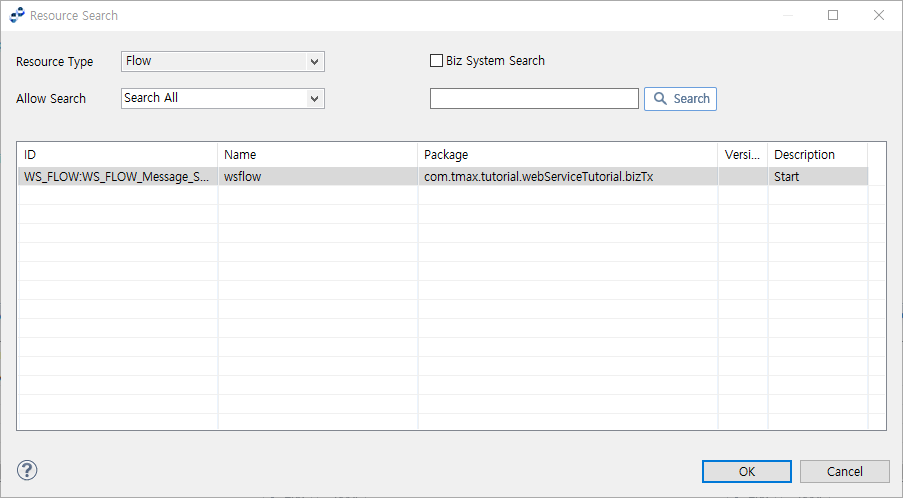 Search Mapping ID (Search Resource)
Search Mapping ID (Search Resource) -
-
MAPPING
Maps Error Response Messages. Defines mapping for each error response message type.
 [BizTx (Group) Info] - [Error Response Mode (MAPPING)]
[BizTx (Group) Info] - [Error Response Mode (MAPPING)]Item Description Error Response Message
Same as "Flow Error Response Mode".
Mapping ID
-
[Search]: Select a message from the Resource Search dialog box (Search Mapping ID (Search Resource)) that displays the map files.
-
[Create]: Open the Mapping dialog box to map a Request Message with an error response message. In the Source section, click the context menu, [Add Source], to add the Request Message. The error response message is displayed in the Target section.
Since the BizTx node’s data object is not created for a system, format, or parsing error response message, only parent node’s messages are displayed when [Add Source] is clicked. Mapping Code can be manually created using [Add Mapping Code].
-
2.2. BizTx/BizTx Group Options
The [BizTx (Group) Options] tab is used to configure Timeout, Fixed Connection, GUID, Response Option, Reliable Message Delivery, and BizTx Priority settings for a BizTx/BizTx Group.
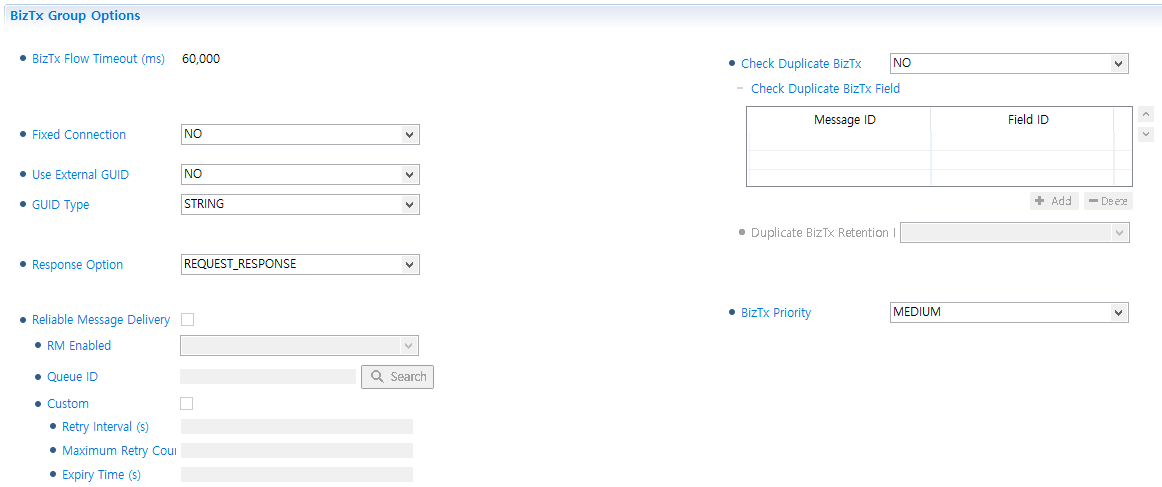
| Item | Description |
|---|---|
BizTx Flow Timeout (ms) |
BizTx timeout. Handled as an error if this time is exceeded.
|
Fixed Connection |
Option to send a message to another MS if a flow correlation error occurs.
|
Use External GUID |
Option to use external GUID as AnyLink GUID.
|
GUID Type |
GUID type.
|
Response Option |
This option can only be used for a Bypass enabled BizTx. Otherwise, it is ignored. |
RM Enabled |
Option to guarantee message delivery. This is available only when Response Option is ONEWAY.
|
Queue ID |
Queue used to guarantee message delivery. The queue to use must be created in advance by selecting [System] > [MQs] in WebAdmin. To open a dialog box where queue IDs can be searched, click [Search]. |
Custom |
Sets the BizTx queue.
|
Check Duplicate BizTx |
|
Check Duplicate BizTx Field |
To add messages and fields, click [+ Add]. To delete them from the table, click [- Delete]. |
Duplicate BizTx Retention Period |
Time period to retain fields extracted for duplication check.
|
BizTx Priority |
|
Select 'MESSAGE' for the 'BizTx Priority' to display the following section.

Click [Search] to open the Select Message Field dialog box.
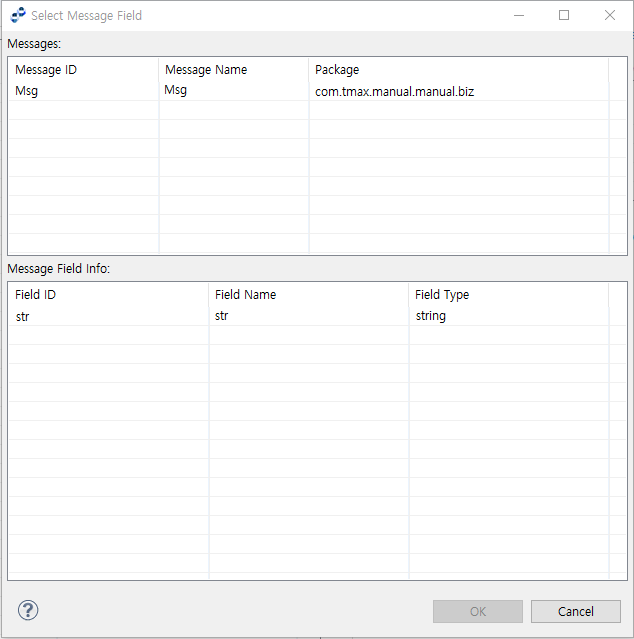
2.3. Parsing Info
The Parsing Info tab is used to define the standard for identifying the child BizTx to process input message for.
-
BizTx Identifier Code
This is required when the 'Async Response BizTx' is checked in the BizTx Info section.
 [Parsing Info] - [Parsing Definition] - BizTx Identifier Code
[Parsing Info] - [Parsing Definition] - BizTx Identifier CodeItem Description Code Value
Identifier code for BizTx.
Type
-
RESPONSE: Normal response handling
-
REQUEST: Request handling
-
ERROR_RESPONSE: Error response handling
To use the Async Response BizTx setting of the Invocation Service, this must be set to 'RESPONSE' or 'ERROR_RESPONSE'.
-
-
Child BizTx Identification
Child BizTx Identification Method can only be set for the BizTx Group. Select a method, click [+Add], and then enter the value and BizTx.
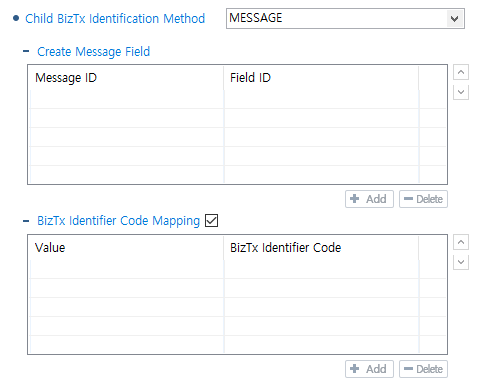 [Parsing Info] - [Parsing Definition] - Child BizTx Identification Method
[Parsing Info] - [Parsing Definition] - Child BizTx Identification MethodItem Description NONE
No BizTx identification.
MESSAGE
Select the BizTx with BizTx Identifier Code that matches the selected message’s field value.
The message’s field value must match the Value of the BizTx’s 'BizTx Identifier Code'.
HANDLER
Mostly used to implement parsing handler.
Select the BizTx with BizTx Identifier Code returned by the parsing handler. The return value of the user class must match the Value of the BizTx’s 'BizTx Identifier Code'.
X_PATH
Only for an XML message.
Select the BizTx with BizTx Identifier Code that matches the X_PATH value. The X_PATH value must match the Value of the BizTx’s 'BizTx Identifier Code'.
OFFESET_LENGTH
The Offset and Length text boxes are displayed when this option is selected.
Select the BizTx with BizTx Identifier Code that matches the OFFSET_LENGTH value. The OFFSET_LENGTH value must match the Value of the BizTx’s 'BizTx Identifier Code'.
SOAP_ACTION
Select the BizTx with BizTx Identifier Code that matches the SOAP_ACTION value.
The SOAP_ACTION value must match the Value of the BizTx’s 'BizTx Identifier Code'.
JSON_POINTER
Select the BizTx with BizTx Identifier Code that matches the JSON POINTER value.
The JSON POINTER value must match the Value of the BizTx’s 'BizTx Identifier Code'.
CONDITION_MESSAGE
If the condition is true, it operates same as MESSAGE according to child MESSAGE settings. If not, the next condition tab is checked.
The condition is true when the selected message’s field is the entered value or there is no condition.
CONDITION_OFFSET_LENGTH
If the condition is true, it operates same as OFFSET_LENGTH according to child OFFSET_LENGTH settings. If not, the next condition tab is checked.
The condition is true when the selected message’s field is the entered value or there is no condition.
HTTP_METHOD
Select the BizTx with BizTx Identifier Code that matches the requested HTTP method. Available only for BizTx requested through an HTTP inbound endpoint.
2.4. Parsing Options
The Parsing Options tab is used to configure the encoding and message types.
-
Encoding Type
 Encoding Type
Encoding TypeItem Description Use Encoding Type
Option to enable adding or deleting parsing options.
Parsing Option
-
All: Use the 'Encoding Value' set for all messages in the BizTx.
-
ENDPOINT: Use the 'Encoding Value' if the ENDPOINT value is 'Option Value'.
-
URL: Use the 'Encoding Value' if the URL value is 'Option Value'.
-
OFFSET_LENGTH: Use the 'Encoding Value' if the OFFSET_LENGTH is 'Option Value'.
-
Offset: Starting offset to begin parsing
-
Length: Number of bytes to parse
-
Encoding
Encoding to use.
-
-
Message Type
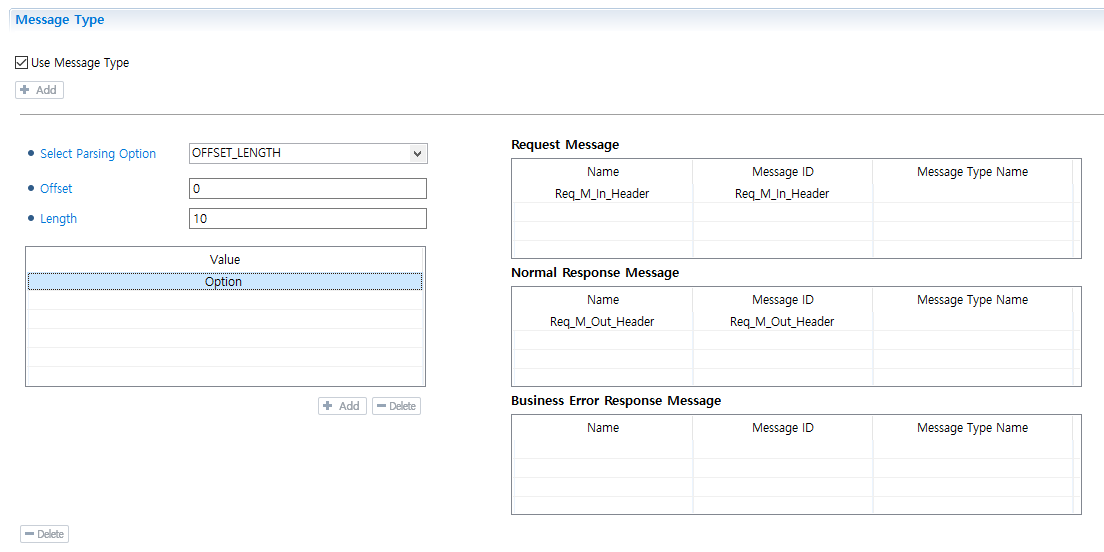 Message Type
Message TypeItem Description Select Parsing Option
Same as the 'Parsing Option' field in "Encoding Type". Convert Request, Normal Response, and Business Error Response Messages to the selected message type according to each option value.
Value
User input value for the selected Parsing Option.
-
XML Self-Closing Setting
 XML Self-Closing Setting
XML Self-Closing SettingItem Description Parsing Option
Same as the 'Parsing Option' field in "Encoding Type". Convert XML Self-Closing Flag according to each option value.
Value
User input value for the selected Parsing Option.
XML Self-Closing Flag
Option to use XML self closing.